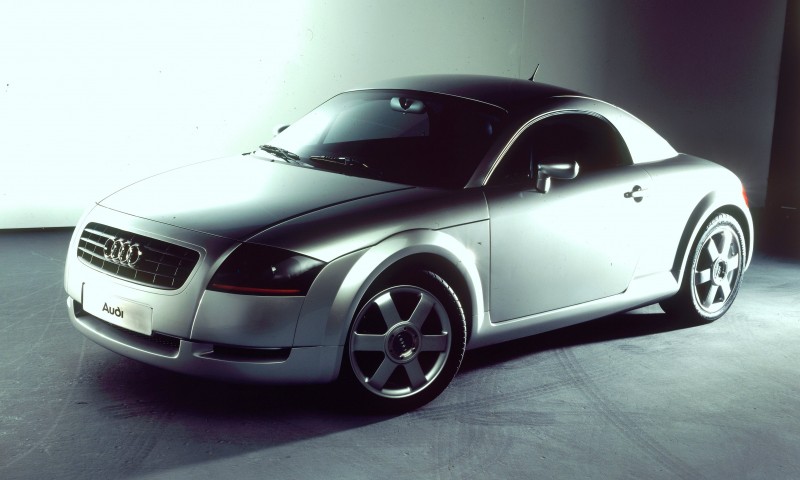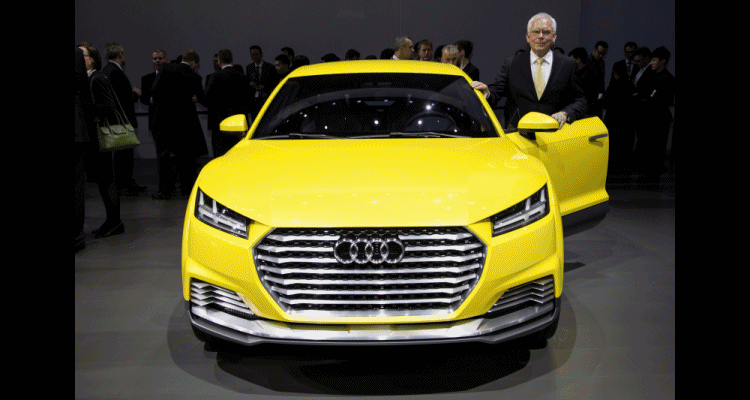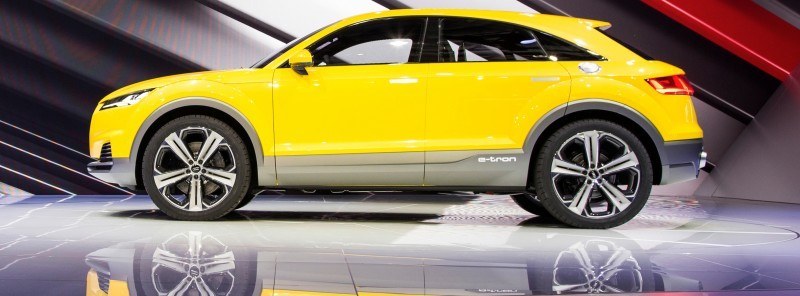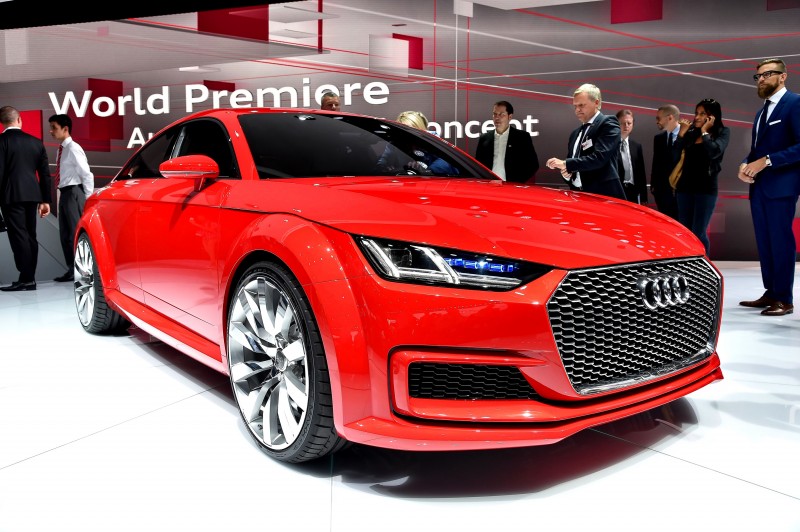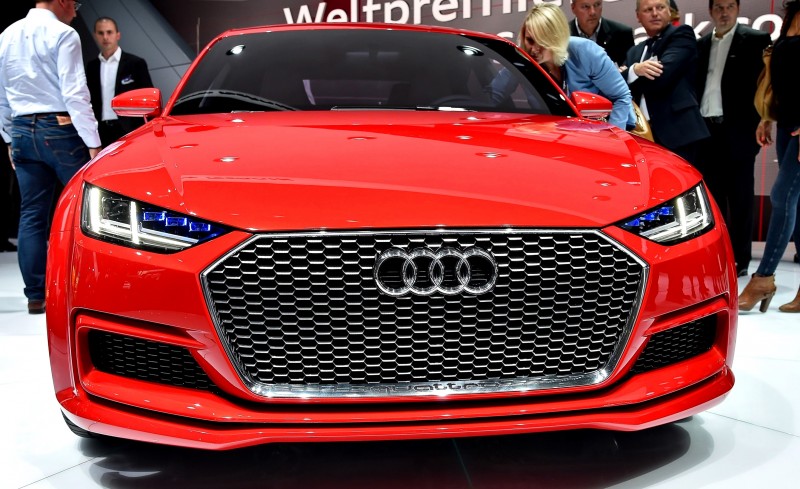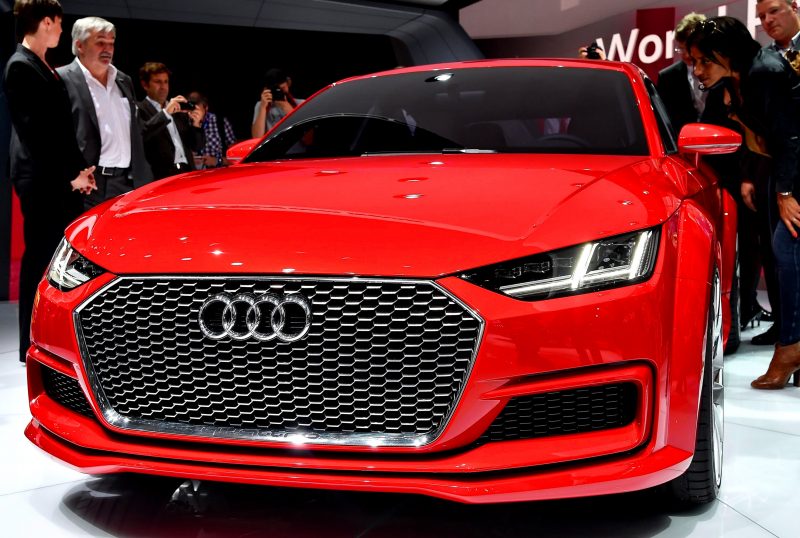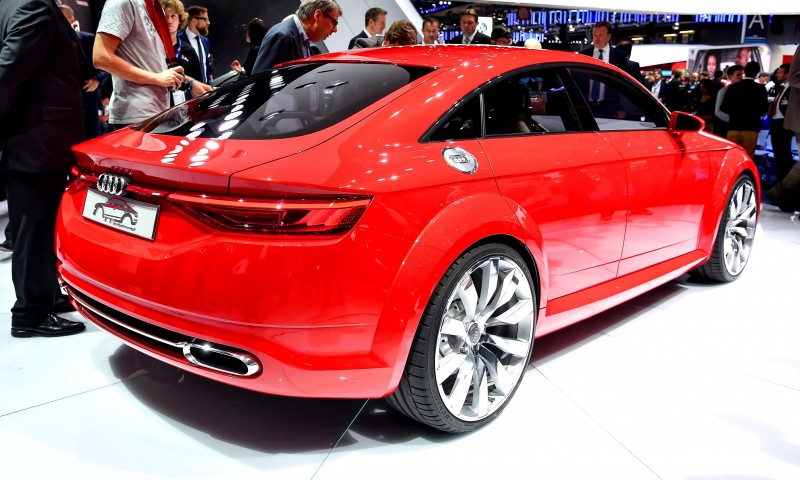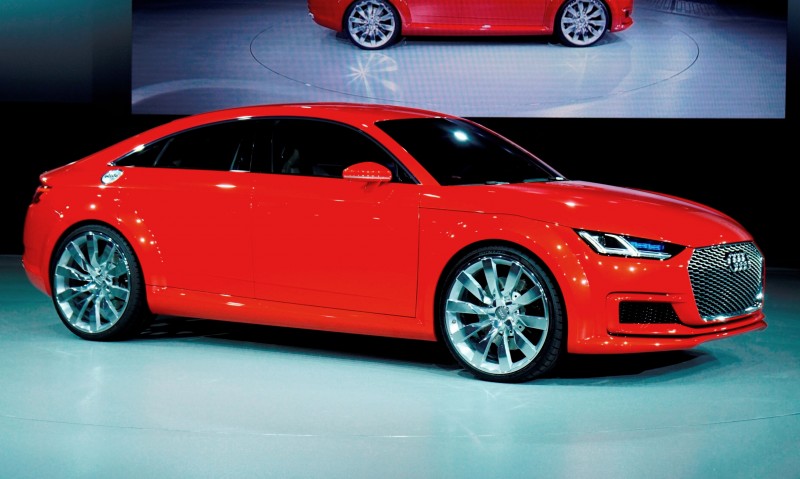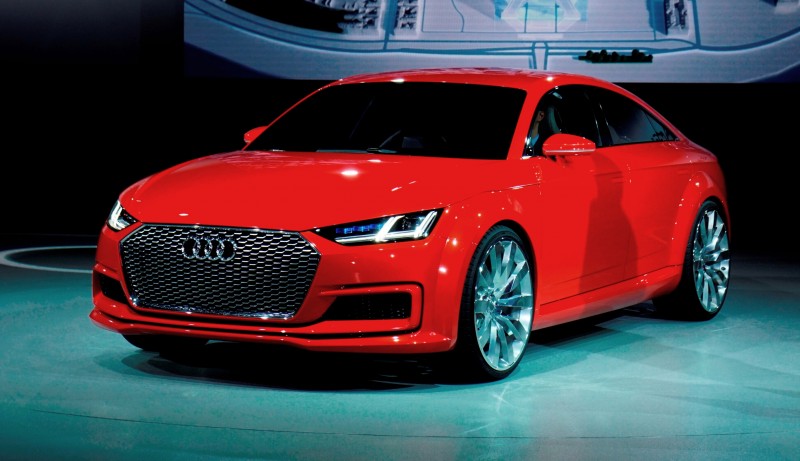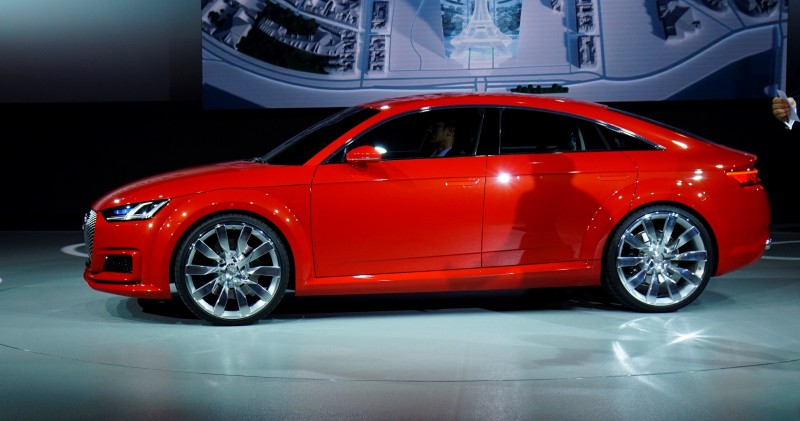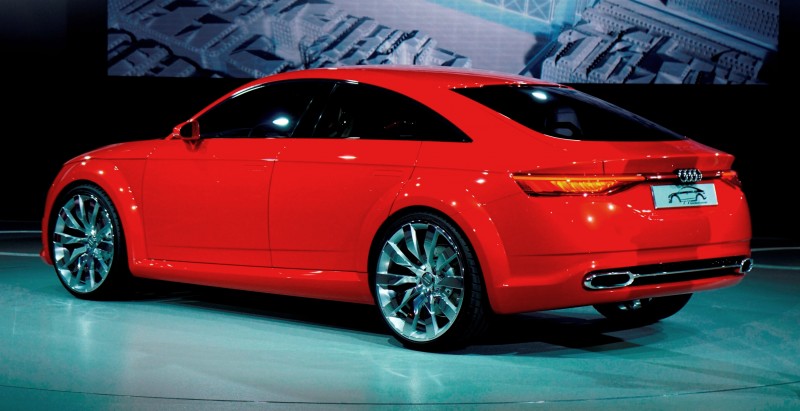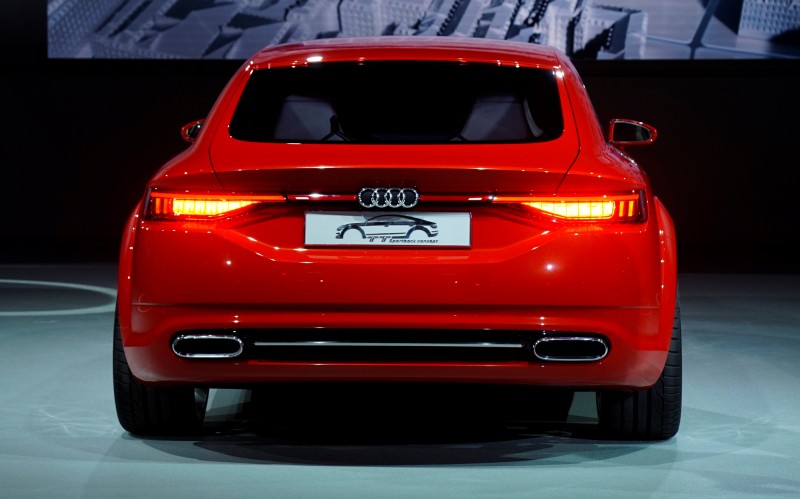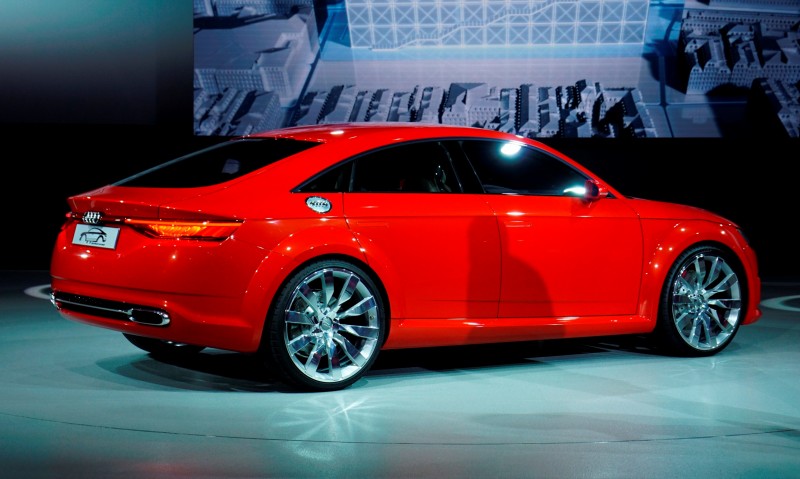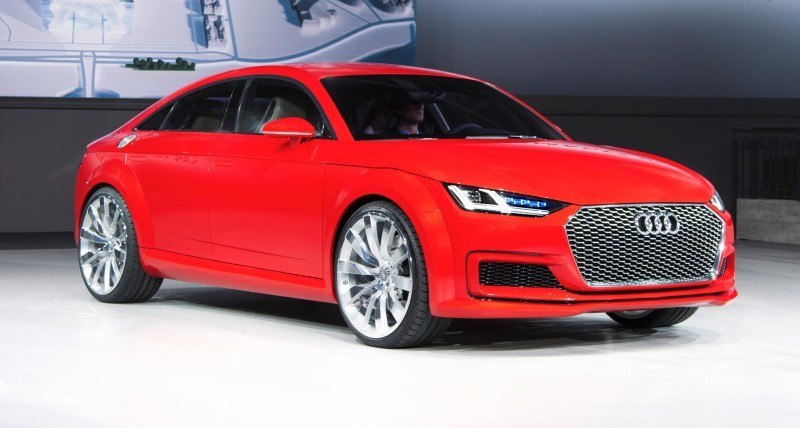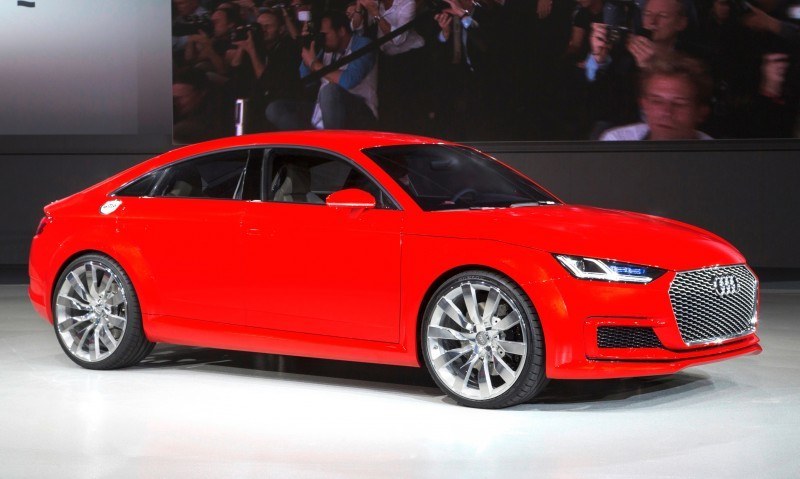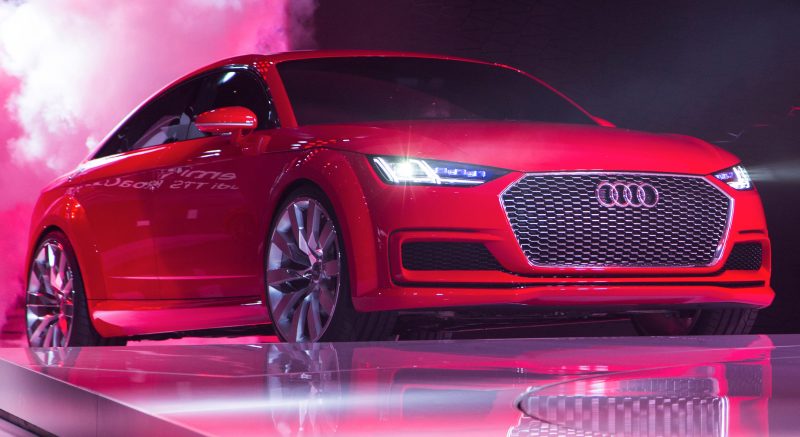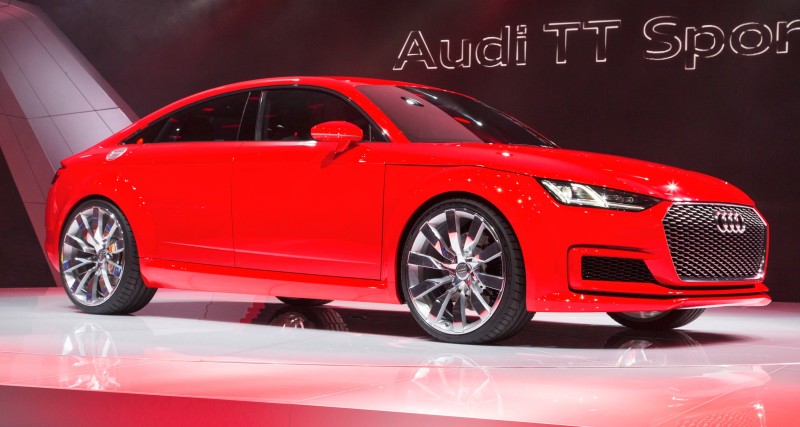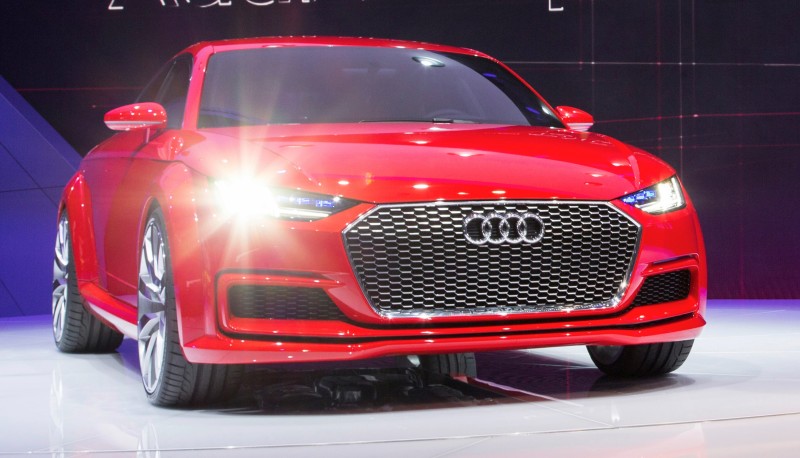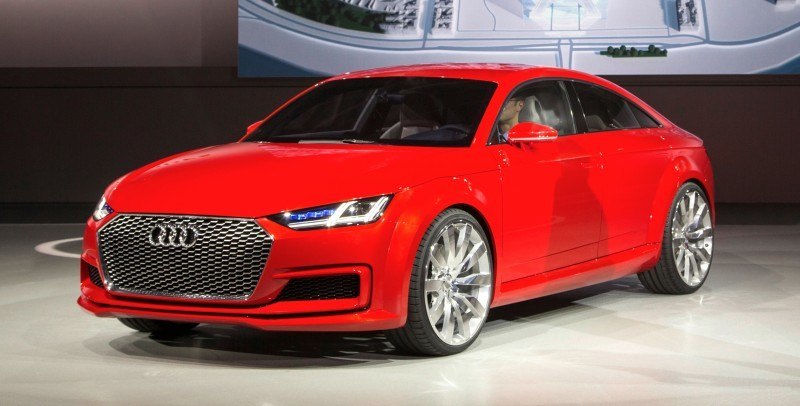Audi design is in a major funk.
After a full 15 years of making BMW and Mercedes seem old and tired and boring, Audi lost the plot some time around 2010. We are not sure what exactly happened, but the magic seemed gone.
The cars started to look like cheap copies of earlier Audi ideas – with the current A6 and new TT perhaps exemplifying this major design problem best. Sure, its proportions are cleaner than ever in 2015, and its new lighting is very dapper indeed. But what the heck?
It looks like a 1999 model.
This is a huge, glaring problem for Audi because BMW is getting more evocative and Mercedes-Benz is making C-Classes and E-Classes that are immediately fresh, new, stylish and hugely desirable.
It is a slow burn to lose the design icon status. But the new TT also shows a lost plot. For lack of a better description, the new TT simply lacks any new ideas. It wears a new chassis and new engines and a far better AWD system doing the tugging — but the looks will rarely make one stop and stare like the first-gen car.
The original TT Concept is shown below, and its themes and ideas are nicely recaptured and remodeled for the 2015 period and beyond.
The four-door coupe formula is barely new, so no shock at a stretched TT sedan. It is a great idea for selling more cars in the coupe-averse US and Chinese markets.
Sliding in between the upcoming A4 redesign and the A6, the TT Sportback will make a nice production car. We hope Audi goes all-in with this TT line extension – the Beijing TT Offroad SUV concept is also very welcome and would sell very well.
For the first time in years, Audi leaps past BMW by adding a real unique design proposition to its TT Sportback. This is a bit lacking when comparing the BMW 335i sedan and the 435i Gran Coupe — which 95-percent of the world would never be able to distinguish.
But these TT cues stand proud. It is curious how much more attractive the TT Sportback is than its actual new TT namesake, but anything to help Audi get back on track.
2014 Audi TT Sportback Concept
A NEW TAKE ON THE AUDI TT – FIVE-DOOR SPORTBACK CONCEPT HEADLINES IN PARIS
Much loved Audi TT formula is remixed to incorporate five doors, a longer wheelbase and a 400PS version of the punchy 2.0-litre TFSI engine
- Concept study for Mondial de l’Automobile in Paris (Oct 4-14) reinterprets Audi TT with extended wheelbase and five doors
- Board Member for Development Prof. Dr. Hackenberg: “TT Sportback concept unites two concepts to form a new member of a potential TT family”
- Four-cylinder TFSI provides 400PS, maximum torque 450 Nm (331.9 lb-ft) and 40mpg-plus potential
Ingolstadt/Paris, October 1, 2014 – Audi has drawn inspiration from its five-door A5 and A7 Sportback models, which artfully blend the rakish lines of a coupé with the real world practicality of an executive class car, to create the TT Sportback concept, which will make its world debut at the Paris Motor Show. Adding 29 centimetres to the length of the ‘standard’ TT to incorporate its extra rear doors, the full four-seat show car takes the famous silhouette in another new conceptual direction, and its 2.0 TFSI engine also expands considerably on its more familiar output in the production coupé, weighing in at a brawny 400PS.
“With the TT, Audi created one of the automotive design icons of the last 20 years,” says Prof. Dr. Ulrich Hackenberg, Audi Board Member for Technical Development. “In the years since, we have designed our sporty and elegant five‑door Audi A5 Sportback and Audi A7 Sportback. In our Audi TT Sportback concept show car, we are now fusing both concepts to form a new member of a potential TT family.”
The mighty 400PS output delivered by the Audi TT Sportback concept flows through a seven-speed S tronic twin-clutch transmission to the quattro permanent all‑wheel drive system, helping to peg the 0 to 62mph sprint time at just 3.9 seconds. The sophisticated suspension and the low centre of gravity ensure dynamic handling, and the body integrates a number of lightweight aluminium components. A laser spot that complements the LED high beam is featured in each of the headlights – this innovation from Audi significantly boosts safety when driving in the dark.
The Audi virtual cockpit dominates the elegantly designed interior of the show car, with the 12.3‑inch screen replacing the conventional instruments and the MMI monitor. The screen provides top-quality graphics and enables the driver to choose between multiple display levels. In the MMI terminal, the rotary push-button features a touchpad that is used to enter characters and gestures as with a smartphone. The operation of the climate control has been relocated to the air vents.
Exterior design
The five-door Audi TT Sportback concept is 4.47 metres long, 1.89 metres wide, and 1.38 metres high, and is built around a wheelbase of 2.63 metres. Compared with the new production TT, it is 29 centimetres longer, 6 centimetres wider, 3 centimetres lower and has a 12 centimetre longer wheelbase.
Featuring Mars red paintwork, the body is a statement of powerful elegance: High-precision lines border athletically domed surfaces, and a flat greenhouse is positioned on a powerful body. The design makes use of the Audi TT’s formal idiom to develop a new sporty and elongated sculpture that is highly taut.
The distinctive horizontal lines at the front end of the new Audi TT Sportback concept reinforce the broad and purposeful stance. Bearing the quattro badge on its lower edge, the Singleframe grille is flatter and wider than on the two‑door coupe and features a honeycomb grille insert with a dark aluminium look.
The lateral borders of the Singleframe grille are continued across the bonnet as swage lines. Typically for Audi, the design forms a coherent whole, with all the lines and surfaces of the show car being linked to one another in a logical manner.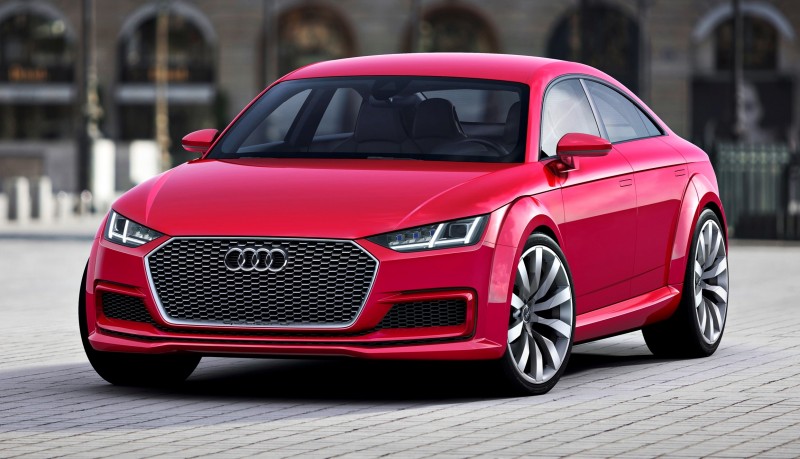
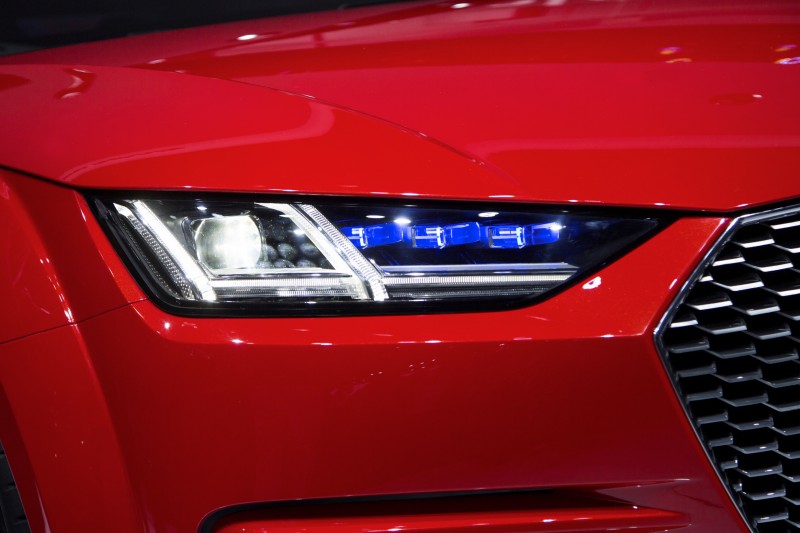
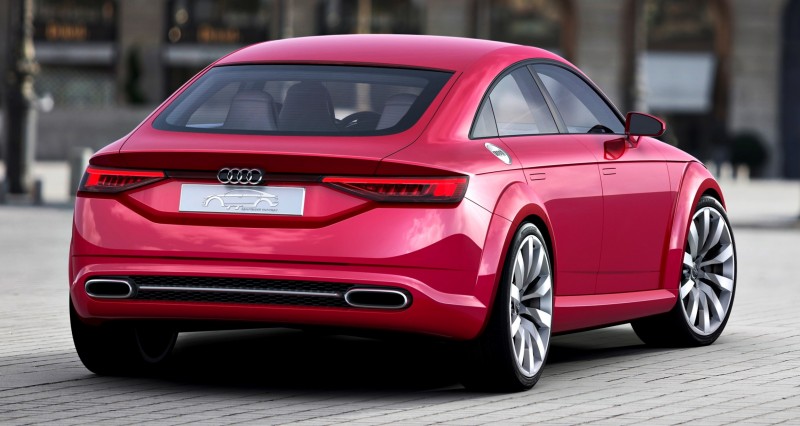
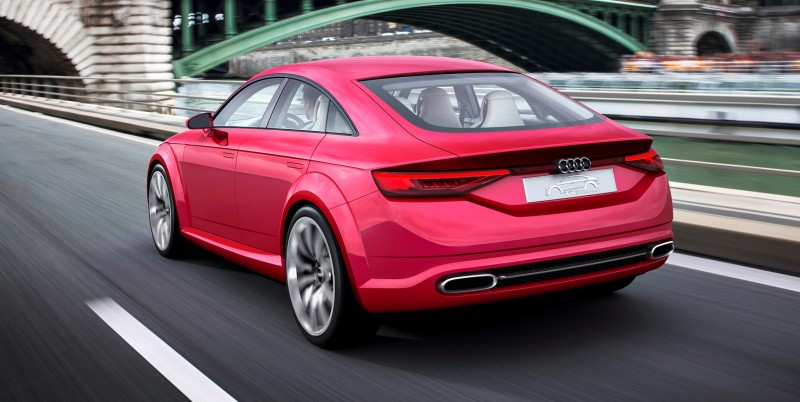
The front of the Audi TT Sportback concept has another characteristic feature in the form of the large, striking air inlets. Framed by pronounced edges, the air inlets have the look of individual structures and feature honeycomb inserts that fill their interior. A third, flat inlet underneath the Singleframe grille connects them to each other. The blade that gives the Singleframe grille structure sharpens the look of the show car whilst boosting the aerodynamics.
Another typical TT design feature are the newly designed headlights with separators that demonstrate a unique daytime running light signature. On the Audi TT Sportback concept, the high-beam spot is provided by laser technology – in each headlight, a module comprising four powerful diodes generates a beam of light that illuminates several hundred metres. The laser spot, which is activated at speeds of 37mph and above, supplements the LED high beam. For the driver, this is a significant boost to visibility and safety; a camera is used to detect and shield other road users from the light projection.
The lighting concept is rounded out by the indicator with a dynamic sweeping function that is also used in the LED rear lights. It comprises a series of individual diodes that light up one after the other from the inside to the outside, indicating the direction selected by the driver.
The side view of the four-seater show car is a particularly striking indication of the close relationship between it and the production TT. The Audi TT Sportback concept sits powerfully on the road and features short overhangs. The wide semicircles of the wheel arches, each of which protrudes by 3 centimetres, have a superimposed look. The front semicircle defines the edge of the bonnet, which runs as a sharp tornado line across the doors and to the rear end.
The trim of the side sill, which connects the wheel arches to one another, also adds to the broad and muscular appearance. In classic sports car style, the exterior mirrors and their angular housings are positioned on the door top shoulders. The right side part houses the circular filler cap, another classic TT icon.
The strong shoulders of the powerful vehicle body support a low greenhouse that is elongated towards the rear. This is in keeping with the Sportback line as implemented by Audi in its A5 and A7 model series. The flat C‑pillar flows elegantly into the shoulder, and the rear has a compact and sleek look. The highly rounded corners of the rear window are a homage to the original TT.
The rear of the Audi TT Sportback concept is also focused and sculptural, with five horizontal lines emphasising its width. The one-piece rear lights – which also include vertical separators inspired by the R18 – form independent structures. These are linked to one another by the handle edge of the luggage compartment, which constitutes a powerfully contoured continuous trim. The surface that bears the number plate is located in the shadow of the spoiler lip. The two large elliptical tailpipes of the exhaust system are embedded in the diffuser and linked by a trim.
Interior
The driver and the passengers enter the Audi TT Sportback concept through doors with frameless window panes. The interior fits around them with the precision of a bespoke suit. In the interior, the sporting overtones of the Audi TT meet the functionality of a four‑door saloon. This is underlined by slimline applications on the dashboard and doors, as well as a long centre console which continues through the entire interior. Handworked seams run along the centre console and top shoulder from the front through to the luggage compartment. The headlining also features an elegant contour that accentuates the length of the interior. The super sport seats with the integrated head restraints are sharply contoured and highly adjustable.
There is space for two people in the rear in individual seats with integrated head restraints. They are separated by functional storage compartments and a comfortable armrest. The backrests can be folded down so that large objects can also be stowed in the luggage compartment beneath the tailgate.
The sinewy, taut lines created by the Audi designers in the interior of the show car are closely oriented to those of the production TT. When viewed from the top, the instrument panel resembles the wing of an airplane and the five round air vents are reminiscent of jet engines. The controls for the seat heating, air recirculation, temperature, distribution and strength of the air flow are located on their axes. The omission of the classic air conditioning control panel and the MMI monitor has made it possible to design the instrument panel within a sleek and light architecture that is fully focused on the driver.
The Audi virtual cockpit, the digital instrument cluster, replaces the conventional physical displays and the central MMI monitor. The driver can switch to the 12.3‑inch display at multiple levels in order to view graphics of exceptional clarity. The system is operated via the multifunction steering wheel or the MMI terminal. The touchpad located on the round rotary push-button is used to enter characters and also processes multiple finger gestures – the driver can zoom in on the map as they would on a smartphone.
The sophistication of the exterior is mirrored in the cabin, which is defined by the use of high-quality materials. The instrument panel and the upper area of the door trims are dark granite grey in colour. The door armrests, the centre console and the seats see the use of a new soft leather in parchment beige – this is processed for a particularly near-natural look and has a silky sheen. The door top shoulder is upholstered in Alcantara, parchment beige. The seat upholstery features a diamond pattern. The side bolsters of the seats are trimmed with special accent strips in dark grey leather that are fixed with red thread using a special stitching technique.
The instrument panel and the door trims contain decorative surfaces with a dark aluminium look. Further accents in this look are provided by the clasps on the sides of the seats and the trim rings on the air vents. The colour and material concept is rounded out by black floor mats made from the rubberised material that also covers the floor of the luggage compartment.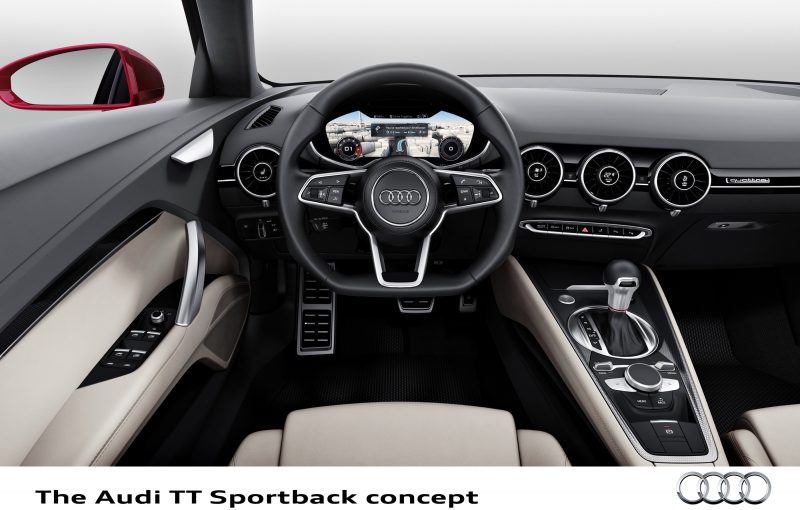
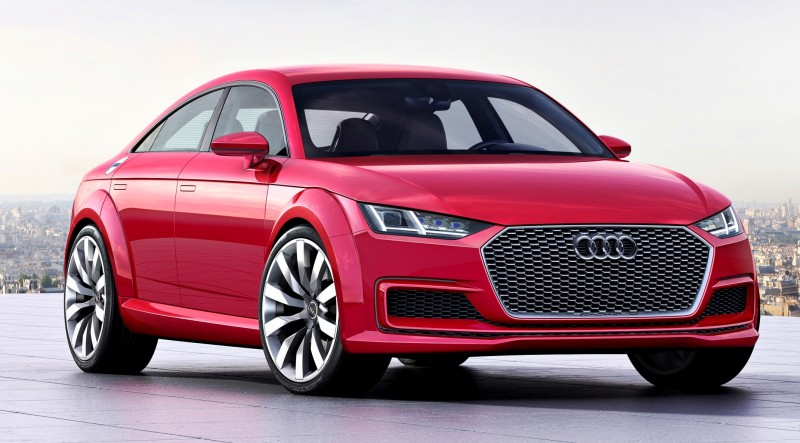
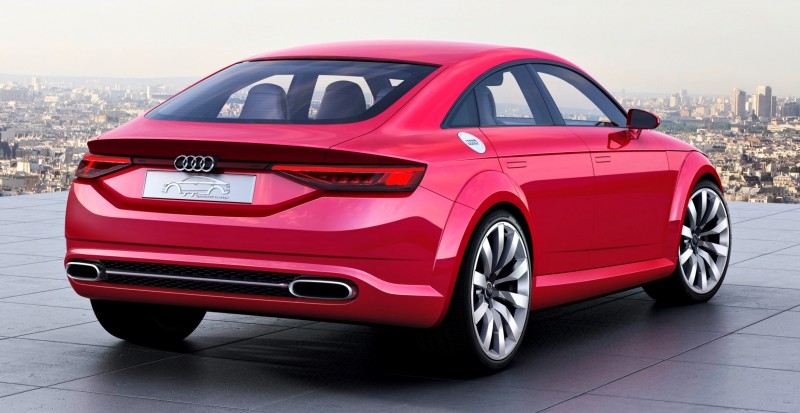
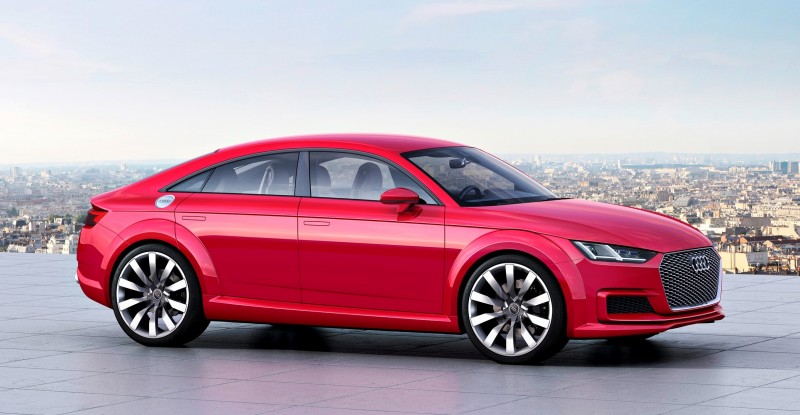
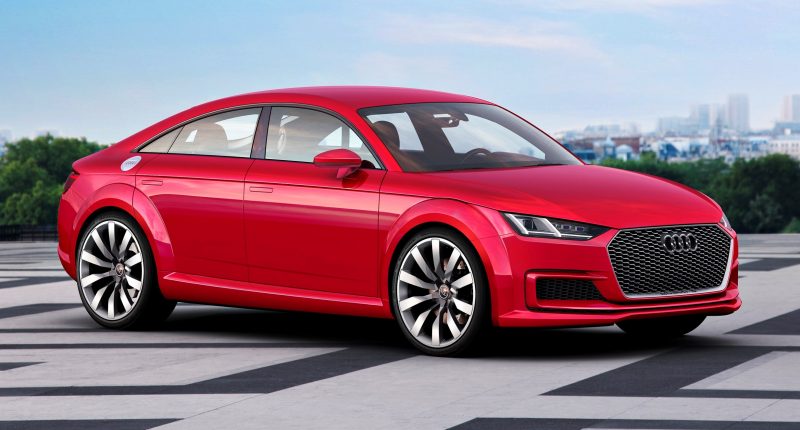
Drivetrain
The 2.0 TFSI engine in the Audi TT Sportback concept generates captivating performance data: It generates 400PS at 6,400 rpm, with a specific output of 200PS per litre of displacement. The four-cylinder engine puts 450 Nm (331.9 lb-ft) of torque on the crankshaft between 2,400 and 6,000 rpm, with over 300 Nm (221.3 lb-ft) already available at just 1,900 rpm, yet it is also good for up to 40.3mpg. This equates to CO2 emissions of 162 grams per kilometre.
As a member of the Audi EA 888 engine family, there is a comprehensive package of high-end technology on board for the turbocharged direct-injection unit. The camshaft adjustment on the intake and exhaust sides and the Audi valvelift system, which varies the stroke of the exhaust valves in two stages, ensure good filling of the combustion chambers. At part load, indirect injection complements the FSI direct injection. The exhaust manifold embedded in the cylinder head is an important component of the thermal management. The flow of coolant is managed by a powerful rotary slide module.
In order to generate the high power output, the 2.0 TFSI unit has undergone extensive modifications, including the integration of special aluminium pistons with an integrated cooling channel and a crankshaft made from ultra-high-strength forged steel. The crankcase consists of a new, high-strength casting alloy and the cylinder head has been designed for the increased gas flow rate. The turbocharger has also been redeveloped and builds up a maximum relative boost pressure of 1.8 bar. It contains a mixed flow turbine wheel that is noted for its particularly fast start-up performance.
The turbocharged direct-injection engine rockets the Audi TT Sportback concept from 0 to 62mph in 3.9 seconds, demonstrating excellent response characteristics and running at 7,200 rpm up to the maximum rated speed. The sonorous sound is made even more resonant as the load and engine speed increase.
The force of the engine flows into a compact seven-speed S tronic with a three-shaft layout that performs direct gear changes in a few hundredths of a second. The driver can let the dual-clutch transmission operate in two automatic programs or take control using the paddles on the steering wheel.
Power is delivered to the road via quattro permanent all‑wheel drive. For optimal weight distribution, the hydraulically actuated and electronically controlled multi-plate clutch is located on the rear axle. The quattro drive actively controls the distribution of torque between the axles in milliseconds, thus adding to the car’s agile handling.
Chassis
The suspension also reflects the technological expertise behind the Audi TT Sportback concept. The front suspension is based on a McPherson system; aluminium components reduce the weight of the unsprung chassis masses. The four-link rear suspension can process the longitudinal and transverse forces separately.
The large wheels have a 21-inch diameter and a tyre format of 255/30. The four brake discs in 18‑inch format feature a weight-saving wave design.
The Electronic Stabilisation Control (ESC) adds the final touch to the handling. A sub-function of the ESC is enabled at the cornering threshold – through minimal application of the brakes at the wheels on the inside of the bend, which have a reduced load, the wheel-selective torque control diverts the drive torque to the wheels on the outside of the bend. For the driver, this means a further boost in terms of neutrality, stability and traction.
Body
The body plays a leading role in the lightweight construction concept of the Audi TT Sportback concept on the basis of the modular transverse matrix (MQB). The entire front section is made from steel. The passenger compartment floor comprises high-strength, hot-shaped steel components which, thanks to their outstanding strength properties, feature thin walls and are correspondingly light. The passenger compartment and all outer skin and attachment parts are made of semi-finished aluminium in the form of cast nodes, extruded profiles and sheet metal.
With its composite concept, the body represents the latest evolution of the Audi Space Frame (ASF). Its hybrid construction ensures that the show car has a low centre of gravity – ideal for more committed driving.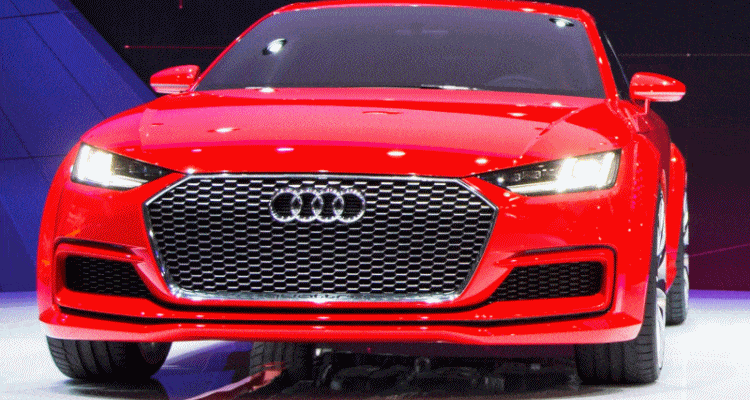

Tom Burkart is the founder and managing editor of Car-Revs-Daily.com, an innovative and rapidly-expanding automotive news magazine.
He holds a Journalism JBA degree from the University of Wisconsin – Madison. Tom currently resides in Charleston, South Carolina with his two amazing dogs, Drake and Tank.
Mr. Burkart is available for all questions and concerns by email Tom(at)car-revs-daily.com.


